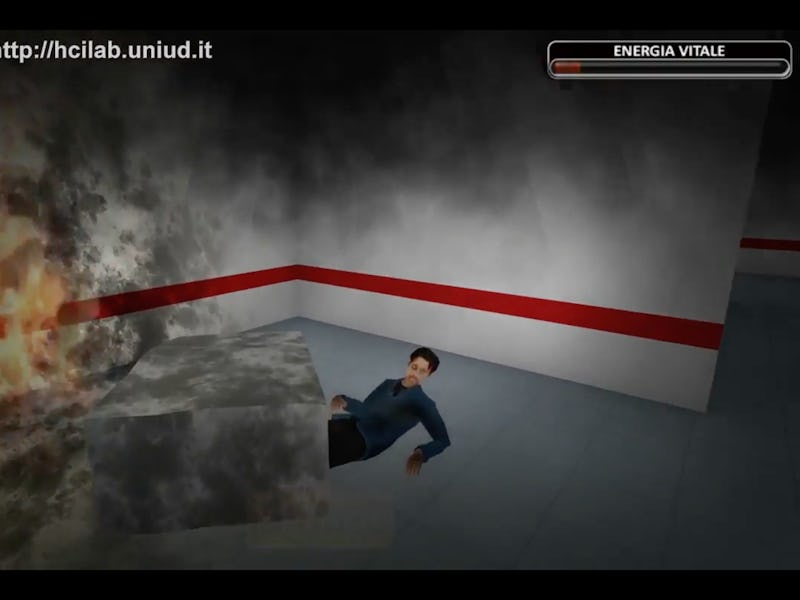Psychologists Use VR to Test Whether You'll Save Someone's Life

Imagine you’re in your school or office when the fire alarm goes off. You snake your way through the corridors, avoiding explosions and walking through clouds of black smoke. All the while, the alarm bells continue to blare in your ears. Your vision narrows as your body gets weak from the smoke and the physical exertion. Just when you feel like you’re about to collapse, you see someone trapped under a fallen piece of debris. He desperately begs for you to help him. What do you do?
This is the stressful scenario portrayed in a virtual reality simulation that psychologist Indrajeet Patil and his colleagues used to test altruism. In a study published on Wednesday in the journal Neuropsychologia, Patil and his fellow researchers found that test subjects who helped the struggling colleague also possessed a larger right anterior insula. This part of the brain, according to the authors, is associated with emotional processing in social situations.
For the purposes of this study, the researchers defined altruism as helping behavior that comes with a significant risk to one’s own life. Patil says that VR offered him and his colleagues a unique way to test altruism without putting anyone in danger.
“In order to study this variety of altruism in an ethically acceptable way in the controlled environment of a lab, we created a novel and emotionally engaging virtual reality environment,” he tells Inverse. He and his colleagues predicted that these results would match subjects’ self-reported feelings of warmth and compassion for others.
In the video, you can see that the subject encounters the ailing man just as the subject’s vital energy is nearing its bottom. This moment tests whether the subject will help someone when their own life is at stake. And even though the simulation is just VR and not real, it’s pretty anxiety-inducing.
After determining whether a subject was an altruist or a non-altruist according to the simulation, Patil and his colleagues used MRI to examine their right anterior insula.
“We found that people who engaged in costly unreciprocated altruistic behavior, which entailed risking one’s own life to save a stranger, had enlarged right [anterior insula] compared to those who preferred to save themselves without helping,” write the authors.
Patil is encouraged by these results.
“I was filled with joy when I finished analyzing the structural brain scans of participants and found out that the altruists had a bigger anterior insula than non-altruists,” he tells Inverse.
This MRI scan shows the slightly larger right anterior insula possessed by the test subjects who risked their avatars' lives to save their colleagues.
Patil tells Inverse that this research emphasizes the significance of compassion over empathy.
“Individuals’ willingness to help someone in need seems to be determined by how much they care for others’ well-being — compassion — and not by how much they share feelings of the person in need — empathy,” he says.
Patil hopes for this research to inform the discussion about how people care for one another.
“What our results argue for is that the best way to motivate people to engage in helping behavior towards others is by cultivating caring motivation,” he says.
Abstract: Costly altruism entails helping others at a cost to the self and prior work shows that empathic concern (EC) for the well-being of distressed and vulnerable individuals is one of the primary motivators of such behavior. However, extant work has investigated costly altruism with paradigms that did not feature self-relevant and severe costs for the altruist and have solely focused on neurofunctional, and not neuroanatomical, correlates. In the current study, we used a contextually-rich virtual reality environment to study costly altruism and found that individuals who risked their own lives in the virtual world to try to save someone in danger had enlarged right anterior insula and exhibited greater empathic concern than those who did not. These findings add to the growing literature showing the role of caring motivation in promoting altruism and prosociality and its neural correlates in the right anterior insula.